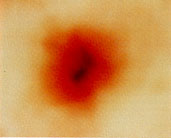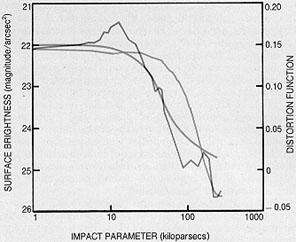


Figure 7a is the "distortion map" that shows the calculated value of T(x,y) for every point on Figure 6, the difference image of the Abell 1689 neighborhood. With this map our software attacks the inverse problem of finding the lensing mass distribution. Figure 7b displays the mass density distribution of our best fit for Abell 1689 as a function of distance from the centroid. For comparison we also plot the averaged radial dependences of T(x,y) and the red-light intensity of the cluster image itself. The radial extent of the mass core thus deduced turns out to be significantly smaller than what one gets from x-ray intensity maps of nearby clusters. Perhaps the x-ray-emitting gas in galactic clusters is less dynamically relaxed than the dark matter.

|

|
Figure 7. For the background of faint blue galaxies in figure 6, the false-color map a shows the distortion function T(x,y) for every point in the field. The darker the color, the greater is the lensing distortion. The mass revealed here is centered on the luminosity centroid of the cluster. In b the averaged radial dependence of this distortion function is plotted (blue curve) against distance from the center of Abell 1689. For comparison we show the averaged radial dependences of the normalized lensing mass distribution (green curve) deduced from T and of the red-light surface brightness (red curve) from the foreground cluster galaxies. |
We see in Figure 7b that the gravitational image distortion extends at least as far out from the center of the cluster as do the visible galaxies. Also, the centers of the two distributions coincide fairly well. This implies that the dark matter distribution is essentially a smoothed version of the distribution of galaxies. Much of the cluster's mass, invisible as well as visible, sits within 100 kpc of a common center.
In much the same way, we looked for evidence of coherent lensing distortion in a dozen patches of sky that had no foreground clusters of galaxies. These searches have thus far revealed nothing.
Our first cluster lens studies would seem to confirm the existence of the large, invisible masses in rich galaxy clusters that had been deduced from the measured velocity dispersions and the assumptions implicit in the use of the virial theorem. But gravitational lensing gives us something extra: a map of the mass. We find the distribution of dark matter in the inner reaches of these clusters to be similar to the distribution of total red luminosity, though smoother on a 100-kpc scale.
By themselves these findings would be consistent with the supposition
that the dark matter concentrated within galactic clusters is baryonic
in origin; it could be a multitude of brown dwarf stars. But baryonic
matter - the ordinary matter made of protons and neutrons - cannot
bring us all the way up to the critical density. The standard scenario
of primordial nucleosynthesis assets that baryons cannot account for
more than about 7% of
 c. Efforts
are under way to detect
brown dwarf stars, or even black holes, in the halo of our Galaxy by
searching for their gravitational "microlensing."
c. Efforts
are under way to detect
brown dwarf stars, or even black holes, in the halo of our Galaxy by
searching for their gravitational "microlensing."
Our cluster results are also consistent with nonbaryonic dark matter composed of remnant neutrinos with rest masses on the order of 10 eV. It is, however, unlikely that such neutrinos dominate the dark matter that is presumed to exist in halos around individual galaxies. 17
Many of the less compact clusters we have looked at show no strong lens distortion effects. Presumably this means that their masses are too small (corresponding to velocity dispersions of less than 700 km/sec) or that their dark matter core radii exceed 200 kpc. The cluster velocity dispersion, being in effect an integral over the distortion function, is the best-determined parameter. Our cluster sample is still too small for us to reach firm conclusions regarding the maximum radial extent of the dark matter.
Our best-fit lens solutions for the rich clusters imply a total velocity dispersion (for dark plus luminous matter) equal to or somewhat smaller than the measured velocity dispersion of the cluster galaxies. For the optically compact clusters, we find peak dark matter densities of about 105 times the critical closure density, and dark matter core radii as large as 60 kpc. We have no data as yet on dark matter beyond 300 kpc from the cluster center.
It is also of interest to inquire on what scale the dark matter clumps together within a cluster. This subclumping has to be on scales significantly larger than individual galaxies; otherwise the long arcs seen in several dynamically relaxed cluster lenses would be broken up into fragments several arcseconds long. As we increase our sample of galaxy-cluster fields, we hope to get a clearer picture of how dark matter distributes itself within clusters. And we may even get some important clues about what it's made of.
These gravitational shear-distortion studies measure the radial mass function M(r), the mass within a distance r of the cluster's center. With only one exception, we find that our results are in good agreement with dynamical measurements of M(r) for those few clusters for which both kinds of data exist. Therefore the gravitational lensing results thus far have strengthened our confidence that the assumptions behind the application of the virial theorem are generally valid for compact clusters of galaxies. Our results also suggest that individual galaxies belonging to clusters are no more massive than lone galaxies, and that the dark matter in a cluster resides primarily in its diffuse component.
What should we expect to find if the universe is just closed by dark
matter? If the mean mass density of the universe is very close to
 c, dark
matter must fill the cosmos; very likely it is to
be found in places where there has been no star formation. After all,
the amount of dark matter we believe to be associated with galaxies
and the inner regions of clusters would still only account for 10% or
20% of
c, dark
matter must fill the cosmos; very likely it is to
be found in places where there has been no star formation. After all,
the amount of dark matter we believe to be associated with galaxies
and the inner regions of clusters would still only account for 10% or
20% of  c.
Therefore we urgently need to study the outer
precincts of clusters, and the seemingly vacant regions beyond.
c.
Therefore we urgently need to study the outer
precincts of clusters, and the seemingly vacant regions beyond.
Gravitational lensing has shown itself to be a useful way of detecting and mapping out accumulations of dark matter. Applying our mapping technique on larger scales may eventually lead us to clumps of dark matter unrelated to galaxies or clusters of them. The cosmologists' "cold dark matter" model, for example, predicts the existence of foreground clumps of dark matter big enough to produce lensing distortions of the background galaxies over patches of sky as large as 1°.
Earlier searches on photographic plates have set upper limits on large-scale shear distortion due to gigaparsec mass clumping or perhaps even to rotation of the universe as a whole. Ultradeep imaging searches for coherent alignments of faint background galaxies over fields several degrees wide may turn up the huge starless clumps of dark matter anticipated by various theoretical scenarios. 18 Wide-field mosaics of CCDs make such large-scale searches particularly attractive.
It is a pleasure to acknowledge my collaborators in the deep imaging work and the development of the image processing software: Gary Bernstein, Bernard Fort, Raja Guhathakurta, John Jarvis, Yannick Mellier, Jordi Miralda-Escude, Roser Pello, Pat Seitzer, Genevieve Soucail, Edward Turner, Francisco Valdes and Rick Wenk.